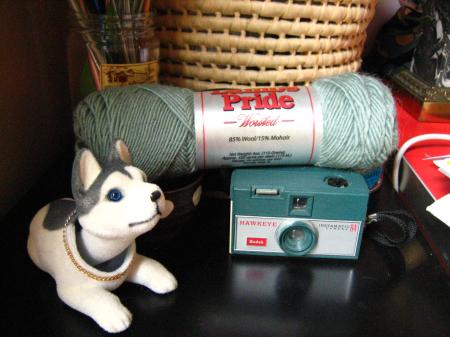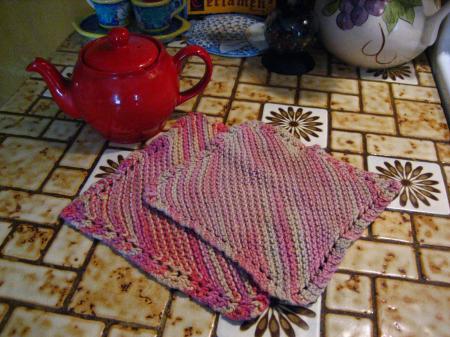By popular demand (hi Amy!), I’m going to talk more generally today about teaching kids to knit, a topic with which I have gotten a lot of help, aid, and succor from members of the Boston Area Stitch ‘n Bitch groups.
I really needed the advice, too, because I am neither a parent myself, nor do I work with younger kids, so I tend to have only the vaguest sense about the developmental stages of children. In other words, I’m clueless. I had also had the experience of attempting to teach an adult friend in Berkeley to knit, only to discover that I really no longer had any conscious awareness of how I do what I do when I knit. I had to return to the fundamentals: what are the individual components of a stitch when they are broken down into units of motion? As I successful teacher of things like English grammar and history of science, I also learned very quickly that teaching someone to do something with a strong physical component was a whole other barrel of monkeys, an unfamiliar barrel of monkeys.
Long story short, what started out as a lesson for my friend became a genuine learning experience for me. It was humbling. And useful. And fun.
Teaching a kid to knit has all those same rewards–and isn’t it great, ultimately, to welcome a new knitter to the fold?–but I knew I should probably get some more expert advice. Here’s a compendium of the good advice and helpful tips I got from those more knowledgeable than me:
1. Some five- and six-year-olds can knit, but not all. Kids will be at different developmental points with their hand-eye coordination and small muscle control. Some kids won’t be ready to knit until they are seven or eight. How to gauge their readiness? The advice I got was that the child is probably ready to learn to knit if s/he likes to draw, can form letters reasonably well for his/her age, can tie his/her shoe laces or make a braid, button small buttons etc.
2. The great needle debate: here there was frankly no consensus. While some people suggested US #5, 6, or 7, this met with an unfavorable response elsewhere by those who swore by US #9 or 10. A maverick even threw down the gauntlet when she argued strongly for US #15.
No shots were fired, however.
There was no agreement on materials either. Acrylic, plastic, bamboo, or good old Boye aluminum?

Well, ask a contentious question, get a contentious answer. I should have known that knitters would have strong opinions about the tools of their craft. (I, for instance, knit almost exclusively with Addi Turbos and have sunk a dollar amount close to the 2005 GNP of Moldova into their purchase. I will admit, however, that they aren’t the best needle for lace. But that’s as far as I’ll go in my concessions…)
So in the spirit of traditionalism, I chose for Miss A. the closest approximation of the needle I had learned on, lo these many years ago: the Susan Bates US #8 aluminum. It was a short needle although the exact specs elude me now.
3. Which brings us to…yarn. Since this is my blog, I’m just going to pull rank on this one and say that you should go getcha some Brown Sheep Lamb’s Pride worsted.

Fabulous, fabulous results because this yarn is a bit sticky so that when mistakes are made (as they inevitably are) or the needle slips out and clatters to the floor (as may well happen), the stitches just stay put. Most excellent! And as you know, Lamb’s Pride comes in a vast range of delightful colors, many of which are bright and would appeal to children. Find out your pupil’s favorite color and go with that. In A.’s case this was easy: pink.
Luckily, both A. and I are pink freaks, so I felt well qualified to help choose a pink yarn for her. We went with the fuschia. We’re nothing if not subtle.
I would not choose a color that is too dark because it makes it harder to see the stiches and therefore more frustrating.
4. Scale. A small project like a potholder or a little garter stitch dishcloth is a nice, doable kind of thing. Here’s a couple of the latter, now faded, but still doing their job:

Or you can just cast on 12 to 15 stitches for your student.
Take-home message: nothing too big or too daunting.
If your student gets frustrated, suggest a break. Most people recommend 10-15 minute sessions. I found that with my little friend that she could knit for quite a bit longer than that, but that she was very astute about when she needed a break. So I could just wait for her to make the call. I’m sure this varies with the kid’s personality.
5. Teaching the knit stitch. It helps to use this rhyme:
“Up the tree
Around the back
Down the tree
Off jumps jack.”
I believe there is a purling rhyme too, but Miss A. and I have not gotten that far yet.
6. Technical advice. Here I will just quote Allison, from Circles, upon whose wisdom I cannot improve:
“I usually cast on and then start knitting very slowly teaching the
child the rhyme. Once she has mastered the rhyme, I have her put her
hands over mine while we go through the motions and repeat the rhyme.
Then I put her hands under mine. Then I let her hold the needles while
I wrap the yarn (and keep the yarn tension). Then I let her try to put
it all together.
I’ve had five year olds that get it in one session and others that took
several times and some that simply needed to wait.”
7. Books. I didn’t use them, but some that were suggested to me were:
Kids Knitting, by Melanie Falick
Kids’ Easy Knitting Projects, by Peg Blanchette
The Workshop Book of Knitting, by Ursula von Wartburg (Out of print; probably best found in your library or on eBay)
I can’t opine on these, but others seem to have used them successfully.
8. If you knit with your student, let him or her see you make lots of mistakes and then model an “appropriate reaction” by being breezy and cavalier about it as you masterfully fix them and show your student how easy this is.
This is great advice. The problem in my case is that this tactic involves, ahem, quite a bit of acting talent. But a lot of you are probably better people and can do it with no problem.
9. Patience is a virtue. Cultivate it, for it will be required.
10. Have fun and hang loose.